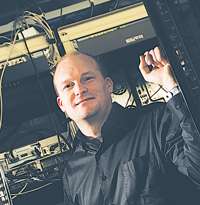Mathematics + Supercomputers = Big Bang Explained

(PhysOrg.com) -- Mathematician Daniel Reynolds is using supercomputers to unravel the mysteries of the Big Bang.
The Big Bang that created the universe more than 13 billion years ago was a huge hodgepodge of chemical reactions. Hydrogen, helium and other gases ultimately began clumping together to form stars, planets and galaxies.
How exactly did that happen?
Scientists now have a better chance of finding answers to that mystery because of the massive computational power of supercomputers - today’s fastest, most powerful computers, says Daniel R. Reynolds, assistant professor of mathematics in Dedman College.
Developing complex models for supercomputers to simulate the physical processes of the Big Bang is a new frontier for mathematicians and
astrophysicists. Reynolds, among those pioneers, says scientists will know they have solved a part of the Big Bang puzzle when they test a model and it results in a simulated universe similar to the one in which we live today.
“Scientists have been able to approximate a great many physical processes in idealized situations. But the true frontier nowadays is to let go of these simplifying approximations and treat the problems as they really are, by modeling all of the geometric structure and the in-homogeneity,” he says.
Now in his second year at SMU, Reynolds teaches applied and computational mathematics. He first made the connection between mathematics and its utility to help him better understand the world in high school calculus and physics classes. Eventually Reynolds earned a doctoral degree in computational and applied mathematics at Rice University. During postdoctoral work at Lawrence Livermore National Laboratory and the University of California, San Diego, he began working with astrophysicists to develop supercomputer mathematical models to understand the Big Bang.
In collaboration with his UC San Diego colleagues, Reynolds has developed a new mathematical model that simulates a slice in time soon after the Big Bang: the so-called “dark ages,” 380,000 years to 400 million years after the universe was born, when gravity pulled gases into the first stars.
With funding from the National Science Foundation, the team has tested its model successfully on two of the largest existing NSF supercomputers: “Ranger” at the University of Texas at Austin and “Kraken” at the University of Tennessee.
A key characteristic differentiates the team’s model from others: “By forcing the computational methods to tightly bind different physical processes together, our new model allows us to generate simulations that are highly accurate, numerically stable and computationally scalable to the largest supercomputers available,” Reynolds says.
The team presented its research at a Texas Cosmology Network Meeting at the University of Texas. Reynolds’ mathematical research also was published in the Journal of Computational Physics.
Provided by Southern Methodist University




















